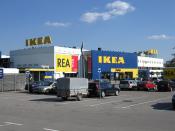IKEA, the Swedish furniture conglomerate, has taken on aggressive growth goals over the past several years in an effort to remain competitive. With this in mind, Michael Porter's "5 Forces" are applied to IKEA for better understanding of the organization as such:
INTERNAL RIVALRY/COMPETITORS- The organization operates in a highly competitive industry, characterized by other low priced furniture producers such as Galiform of England and retailers such as Wal-Mart of the United States. Internally, the organization, according to some accounts, has seen differences of opinion regarding product offerings and positioning. Due to the intense competition worldwide, IKEA has wisely attempted to compete by entering the markets which typically pose the largest competition, such as China and Japan (Caplan, 2006).
SUPPLIER POWER- As an example of IKEA, in recent years, had heard from its customers that many of its furniture offerings were too complicated to be assembled by the customer; showing the power of the supplier to make a difference, IKEA has gotten cooperation from some suppliers to provide materials that are easier for the customer to assemble, thereby adding value to the supplier relationship.
BUYER POWER- Buyers have a great deal of influence over IKEA's product line and direction; for example, in the 1960s, IKEA developed the ability to package its unassembled furniture in flat cartons, making it easier for the buyer to handle the cartons. This was a response to direct feedback from the buyer. Additionally, due to buyer demand, IKEA will continue on its current growth strategy, which includes the opening of 50 stores in North America by 2010 (Caplan, 2006).
POTENTIAL ENTRANTS- Domestically, IKEA faces the threat of potential entrants; as the dominant firm, holding 25% of the market in its native Sweden for example, there is a very real possibility that others will enter the...



Violethouse!!!
Dear, You have rated this essay as negative, would you please let me know any problems with the essay? Best regards
6 out of 8 people found this comment useful.